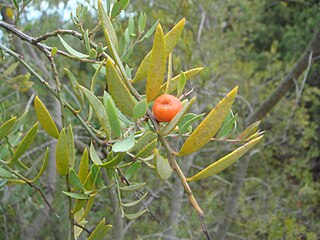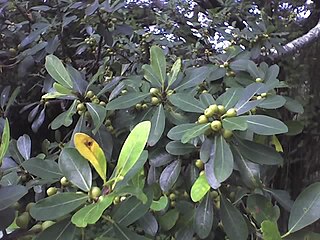
Xylotheca kraussiana is an African shrub or small multi-stemmed tree in the family Achariaceae. It grows in the sandveld and is widely distributed throughout the eastern parts of Southern Africa, in particular the eastern Transvaal, coastal Natal and Mozambique, preferring the sandy soils of coastal bush and forest.
Litsea travancorica is a species of plant in the family Lauraceae. It is a tree that grows from 7 to 10 metres tall. It is endemic to the Western Ghats of southern India, in the states of Karnataka, Kerala, and Tamil Nadu. It grows in semi-evergreen and evergreen montane rain forests from 800 to 1,200 metres elevation.

Rothmannia annae is a species of plant in the family Rubiaceae. It is endemic to the Seychelles. It is found in its natural state only on Aride Island, where its habitat is protected by Island Conservation Society.

Rothmannia is a genus of flowering plants in the family Rubiaceae. It was described in 1776 and is named for Göran Rothman (1739–1778) by Thunberg – both were pupils of Linnaeus.
Vatica globosa is a tree in the family Dipterocarpaceae, native to Borneo. The specific epithet globosa means "spherical", referring to the nuts.

Osyris lanceolata, also known as African sandalwood, watta bush or Camwood, is used for its scented wood and to extract essential oil. The semi-parasitic plant is found from South Africa to Zimbabwe and east Africa, including Tanzania, Kenya and Uganda; northwest Africa; the Canary Islands and the southern half of the Iberian Peninsula. It grows in rocky areas or along the margins of dry forest, but is usually not abundant in any one place.
Avena abyssinica, also known as the Ethiopian oat and "Ajja" by Ethiopians, is a member of the family Poaceae. This grain has long been used in Ethiopia and is well adapted to the high elevations and other conditions there. Still a traditional food plant in Africa, this little-known grain has potential to improve nutrition, boost food security, foster rural development and support sustainable landcare.

Ochna serrulata is an ornamental garden plant in the family Ochnaceae which is indigenous to South Africa. It is planted in southern African gardens and is an invasive species in Australia and New Zealand.

Dalbergia retusa is a plant species in the familyFabaceae . It is found in Pacific regions of Central America, ranging from Panama to southwestern Mexico. It produces the cocobolo wood. It is a fair-sized tree, reported to reach 20–25 m in height. This is probably the species contributing most of the wood in the trade. Because of the wood's great beauty and high value, the trees yielding this wood have been heavily exploited and are now rare outside national parks, reserves, and plantations.

Ficus natalensis is a tree in the family Moraceae. It is commonly known as the natal fig in South Africa. In central and western Uganda, where it has an important cultural value, it is known as omutuba to the Baganda people and omutoma to the Banyakitara peoples. In English is sometimes referred as barkcloth fig. It is commonly mistaken for its cousin the Ficus thonningii also known as mugumo to the Agikuyu. These trees are distributed from north-eastern South Africa to Uganda and Kenya.

Croton sylvaticus is a tree in the family Euphorbiaceae. It is commonly known as the forest fever-berry. These trees are distributed in forests from the east coast of South Africa to Tropical Africa. It grows 7–13 metres (23–43 ft) in height, occasionally up to 30 metres (100 ft), in moist forests, thickets and forest edges at altitudes of 350–1,800 metres (1,100–5,900 ft).

Sclerocroton integerrimus, the duiker berry, is a tree in the family Euphorbiaceae. It is from Southern Africa.

Steganotaenia araliacea is a species of flowering plant in the family Apiaceae. It is found in Angola, Benin, Botswana, Cameroon, Democratic Republic of Congo, Ethiopia, Kenya, Mozambique, Namibia, Somalia, South Africa, Sudan, Tanzania, Togo, Uganda, Zambia, Zimbabwe.

Combretum kraussii, the forest bushwillow, is a medium-sized to large tree in the family Combretaceae. It is found in eastern South Africa, Eswatini and southern Mozambique, in the vicinity of forests. The specific name commemorates Dr. F. Krauss who undertook a collecting trip to South Africa from 1838 to 1840.
Vangueria venosa is a species of flowering plant in the family Rubiaceae. It is found in Mozambique, Eswatini and the former Transvaal region.

Acokanthera oblongifolia is a plant in the family Apocynaceae. It grows as an evergreen shrub or small tree up to 6 metres (20 ft) tall. Its fragrant flowers feature a white tinged pink corolla. The berries are purple when ripe. Its habitat is dry forest and coastal thickets. Acokanthera oblongifolia is used in local African medicinal treatments for snakebites, itches and internal worms. The plant has been used as arrow poison. The species is native to Mozambique and South Africa.

Gardenieae is a tribe of flowering plants in the family Rubiaceae and contains about 586 species in 53 genera.

Cassinopsis ilicifolia is a spined, straggling shrub or liane in the family Icacinaceae. It is native to the moister regions of southern Africa. It is named ilicifolia due to the leaves with somewhat serrated leaf margins, which resemble those of the genus Ilex.
Rhopalocarpus lucidus is a tree in the family Sphaerosepalaceae. It is endemic to Madagascar.

Uvariopsis guineensis is a species of plant in the Annonaceae family. It is native to Guinea, Ivory Coast, Liberia, and Sierra Leone. Ronald William John Keay, the botanist who first formally described the species, named it after Guinea, then called French Guinea, where the specimens he examined were collected near a locality he identifies as Fassakoidou.
















